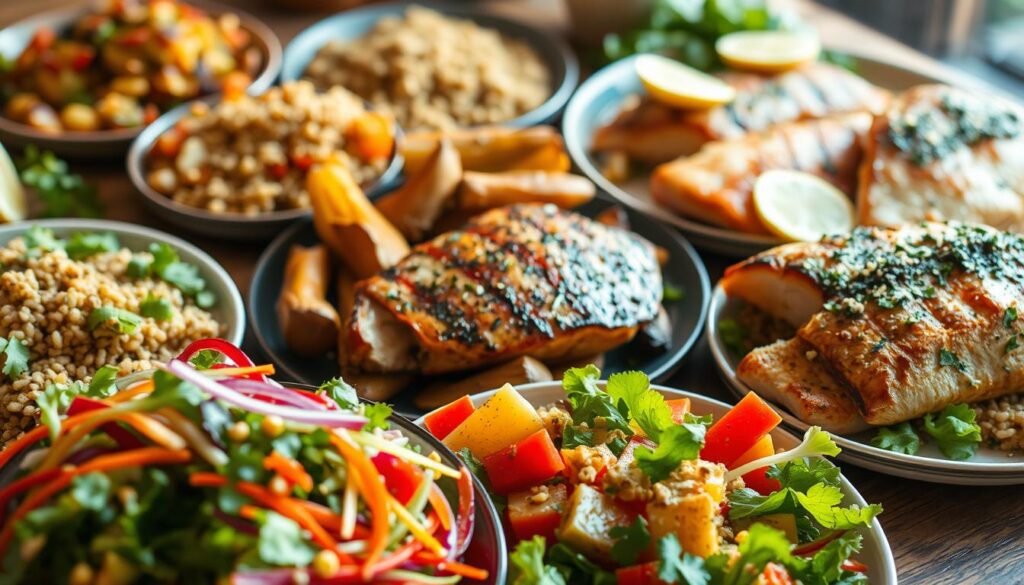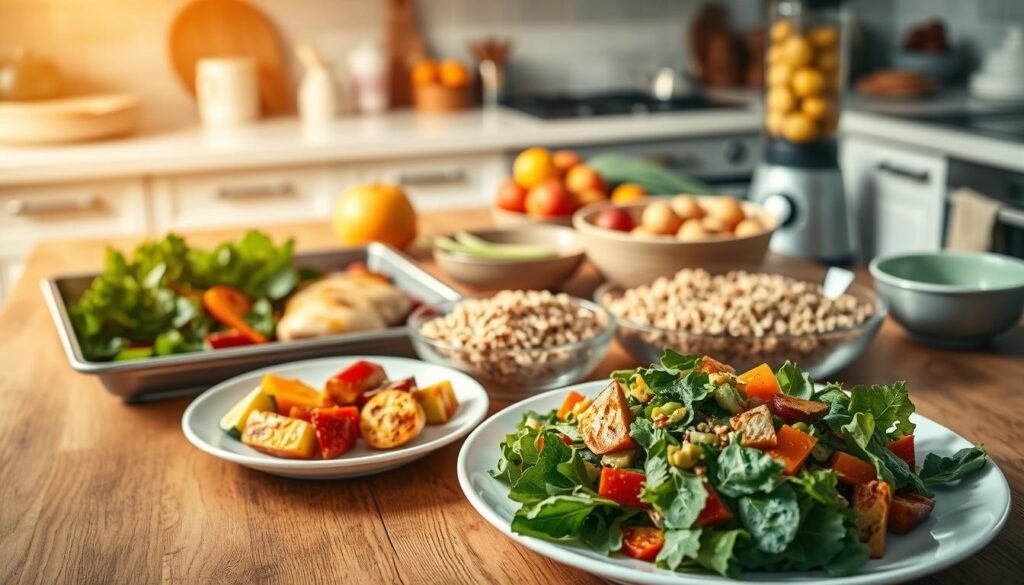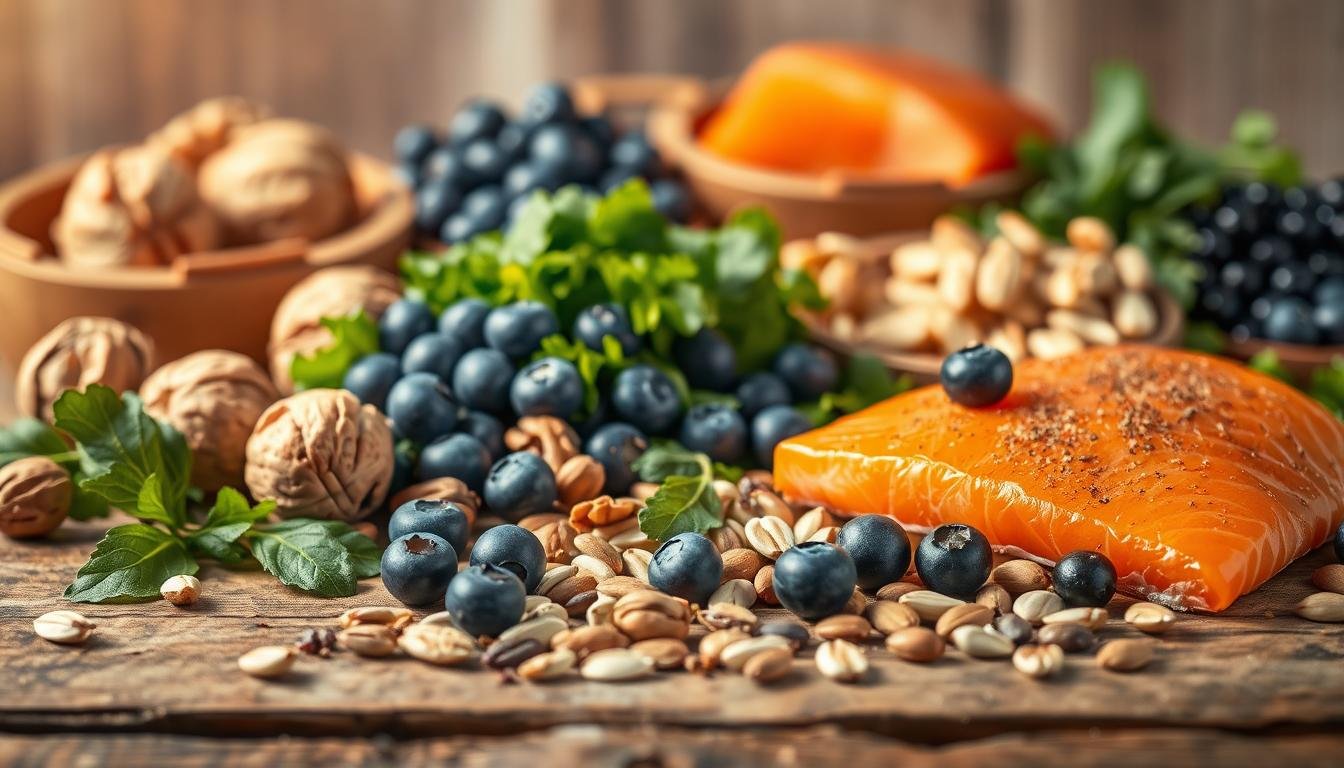Imagine meals that boost your energy and make you feel good without losing taste. Clean eating recipes are changing how we cook and eat. They show how whole foods can turn your diet into a source of energy, not just calories.
Healthy meals don’t have to be hard to make. These recipes use fresh ingredients for tasty dishes that fit any lifestyle. You’ll find quick breakfasts and hearty dinners that meet your health goals. Whether you’re cutting down on processed foods or adding more nutrients, there’s something for everyone.
Key Takeaways
- Clean eating focuses on whole, unprocessed foods for lasting energy and health.
- Healthy meal ideas in this guide work for vegan, gluten-free, and keto diets.
- Whole food recipes are easy to prepare and packed with flavor, keeping meals exciting.
- These dishes support digestion, mental focus, and long-term wellness goals.
- Every recipe balances nutrition and convenience, showing clean eating is easy to begin.
What is Clean Eating?
Clean eating focuses on foods that are not heavily processed and are full of nutrients. It means choosing foods that are as close to their natural state as possible. This way, you avoid artificial additives, too much sugar, and overly refined products.
By sticking to whole food recipes, this lifestyle helps you stay energized and healthy.
Definition of Clean Eating
Clean eating is all about eating foods in their purest form. It started as a way to move away from processed diets and towards meals that really nourish the body. Unlike strict diets, it’s about finding balance by focusing on quality, not just counting calories.
For example, a clean eating recipe might be roasted veggies with quinoa, not a box meal full of preservatives.
Key Principles of Clean Eating
- Choose whole foods: Go for fruits, veggies, and unrefined grains like oats or brown rice.
- Limit refined sugars: Swap soda for infused water and use dates or bananas as natural sweeteners.
- Focus on lean proteins: Choose grilled chicken, legumes, or wild-caught fish over processed meats.
- Read labels: Steer clear of additives like high-fructose corn syrup or artificial dyes in packaged foods.
Following these tips helps make nutrient-dense meals that keep you energized without losing flavor. Clean eating isn’t about being perfect. It’s a way to make choices that support your health in the long run.
Benefits of Clean Eating
Switching to clean eating changes how your body works. Nutrient-dense meals give you vitamins and minerals instead of empty calories. This makes your body run better.
Science shows that whole foods keep blood sugar stable. This stops the energy crash that sugary snacks cause. Long-term health benefits are also linked to this change.
Improved Energy Levels
Processed foods give a quick energy boost but then crash. Clean eating keeps your energy steady. A 2022 study in the American Journal of Clinical Nutrition found a 20% energy boost after six weeks.
“I stopped reaching for coffee after lunch,” says Sarah, a clean-eating fan. “My afternoon slumps vanished.”
Enhanced Digestion
High-fiber nutrient-dense meals help with digestion and reduce bloating. The journal Nutrients says clean diets cut digestive issues by 35%. Removing artificial additives helps your body work better.
Better Mental Clarity
Brain fog goes away when you avoid processed foods. Clean nutrients like omega-3s from fish or antioxidants in veggies improve focus. A
2021 Harvard study noted clearer thinking in subjects eating plant-focused diets
. Adding organic cooking inspiration, like roasted veggie bowls, boosts these benefits.
Quick and Easy Clean Eating Recipes
Even when you’re busy, you can still eat well. These clean eating recipes and healthy meal ideas are quick and delicious. They won’t take up too much of your time.
A balanced diet starts with meals that fit your pace. Choose recipes that fuel your day without the hassle.” – Nutrition Today Journal
15-Minute Breakfast Ideas
Start your day off right with these sugar-free recipes:
- Overnight Oats: Mix rolled oats, almond milk, and chia seeds in a jar. Add berries or cinnamon before refrigerating overnight. Ready in 10 seconds, 300 calories.
- Vegetable Egg Muffins: Whisk eggs with spinach, mushrooms, and bell peppers. Bake in muffin tins for 20 minutes. Store in the fridge for 4 days.
Simple Lunch Bowls
Make these healthy meal ideas your own with fresh veggies:
- Quinoa Power Bowl: Toss cooked quinoa with black beans, avocado, and a lime-cumin dressing. Add grilled chicken or tofu for protein.
- Chickpea Spinach Bowl: Sauté chickpeas with garlic and turmeric. Layer over mixed greens with cherry tomatoes and a tahini drizzle.
Snacks for On-the-Go
Keep your energy up with these sugar-free recipes:
- Energy Balls: Blend dates, almond butter, and cocoa powder. Roll into bite-sized portions. Refrigerate for 1 hour.
- Trail Mix: Combine raw almonds, pumpkin seeds, and dark chocolate chips (85% cocoa). No added sugars).
These recipes focus on whole foods and are quick to make. You can adjust them to fit your diet and what’s in season. They’re perfect for busy days, taking less than 25 minutes to prepare.
Clean Eating Dinner Recipes
End your day with meals that focus on whole foods and vibrant flavors. These clean eating recipes are simple to make. They ensure you get lots of nutrition without losing flavor.
“A great dinner starts with ingredients that are as nourishing as they are satisfying.”

Delightful Grilled Salmon
Marinate salmon fillets with olive oil, garlic, and thyme before grilling. Grill them until they’re golden. Serve with roasted Brussels sprouts and roasted butternut squash.
Choose wild-caught salmon for more omega-3s. Add a light citrus vinaigrette for extra freshness.
Flavorful Quinoa Stir-Fry
Combine cooked quinoa with sautéed zucchini, red onion, and edamame. Add tamari sauce and sesame seeds for depth. This plant-based dishes option uses organic veggies to reduce pesticide exposure.
Double the batch for quick weekday lunches.
One-Pan Chicken and Veggies
Cut chicken breasts into strips and toss with cherry tomatoes, garlic, and spinach. Roast at 400°F with olive oil and rosemary until tender. This dish uses minimal seasoning—just salt, pepper, and smoked paprika—for a clean flavor profile.
Add a side of steamed broccoli for added fiber.
Meal prep tip: Cook extra quinoa or veggies on Sunday for easy assembly during busy evenings. Store in airtight containers for up to three days.
Clean Eating for Special Diets
Clean eating recipes can fit any diet without losing the whole-food focus. You can avoid animal products, gluten, or carbs by using natural ingredients. This keeps you on track with your clean eating goals.
Vegan Clean Eating Recipes
Plant-based dishes are great for clean eating. They use whole-food proteins like lentils, chickpeas, and tofu. Try these:
- Black bean tacos with avocado crema
- Spinach and cashew stir-fry
- Chickpea curry with coconut milk
Gluten-Free Options
Grains like quinoa, millet, and teff are naturally gluten-free. Stay away from processed gluten-free snacks. Instead, choose:
- Wild rice pilaf with roasted veggies
- Buckwheat pancakes made with almond flour
- Zucchini noodles with sun-dried tomato pesto
Keto-Friendly Meals
For keto diets, focus on high-fat foods like avocado, nuts, and olive oil. Try these:
- Lettuce wraps with turkey and cream cheese
- Avocado-stuffed chicken breasts
- Cheese cauliflower rice bowls
| Diet | Key Ingredients | Example Recipe |
|---|---|---|
| Vegan | Lentils, tofu, spinach | Lentil and vegetable stir-fry |
| Gluten-Free | Quinoa, almond flour, zucchini | Quinoa-stuffed peppers |
| Keto | Avocado, coconut oil, spinach | Spinach and bacon frittata |
When you shop, look for brands like Bob’s Red Mill for gluten-free grains. Thrive Market is good for bulk plant-based proteins. Always read labels to avoid added sugars or additives.
Family-Friendly Clean Eating Recipes

Starting clean eating with your family is easier when everyone enjoys the food. These healthy meal ideas make it simple to switch to whole foods. They keep everyone’s taste buds happy.
Kids’ Favorite Clean Snacks
Get kids excited with colorful, fun snacks:
- Fruit kebabs drizzled with honey-almond butter dip (sugar-free recipes)
- Homemade veggie chips baked with olive oil and sea salt
- Apple slices dipped in organic peanut butter
“Letting my kids help chop veggies turned them into snack creators!” – Sarah, mother of three
Nutrient-Packed Family Dinners
Make meals both nutritious and tasty with these tips:
| Meal | Ingredients | Tips |
|---|---|---|
| Colorful Stir-Fry | Chicken, broccoli, bell peppers, sesame seeds | Serve with soy sauce or coconut aminos |
| Meatball Mondays | Turkey, zucchini, whole-grain breadcrumbs | Shape into fun animal shapes |
Begin with small steps: Replace one meal a week with whole food recipes. Let kids pick new veggies each week. This slow approach helps build lasting habits.
Seasonal Clean Eating Recipes
Eating with the seasons brings vibrant organic cooking inspiration and ensures you enjoy nutrient-dense meals at their freshest. Seasonal ingredients taste better and support local agriculture. They also reduce environmental impact. Whether it’s summer’s crisp vegetables or winter’s hearty roots, here’s how to adapt clean eating recipes year-round.
Fresh Summer Salads
Summer’s bounty shines in light, refreshing dishes. Try a watermelon-feta salad with arugula, balsamic glaze, and a lemon-tahini dressing. Swap store-bought dressings for homemade mixes using olive oil, herbs, and citrus. Pair with grilled shrimp for a protein boost.
Cozy Winter Soups
Embrace winter’s warmth with butternut squash soup blended with apple, ginger, and a dash of cinnamon. For a savory option, roast root vegetables like carrots and parsnips into a hearty stew with lentils and turmeric. Use low-sodium broth to keep sodium levels in check.
Follow this seasonal guide for peak flavor:
- Spring: Asparagus, peas, strawberries
- Summer: Berries, corn, zucchini
- Fall: Apples, Brussels sprouts, pears
- Winter: Citrus, kale, sweet potatoes
Preserve abundance by freezing berries for smoothies or canning tomatoes. Swap ingredients in recipes based on what’s fresh locally—your taste buds and body will thank you.
Meal Prep for Clean Eating
Mastering meal prep makes clean eating easy, even when you’re busy. These meal prep tips help you cook efficiently, saving time and keeping your diet healthy.
Batch Cooking Essentials
Begin your weekends with 3 hours for batch cooking. Focus on versatile foods like roasted sweet potatoes, chickpeas, and quinoa. Use a slow cooker or sheet pan to make prep easier. Here’s a simple schedule:
- Roast 4–6 vegetables (broccoli, carrots, zucchini) at 400°F for 25 minutes.
- Cook grains like brown rice or farro in bulk.
- Portion pre-cooked proteins (grilled chicken, lentils) into meal-sized containers.
Storage Tips for Freshness
Keep your food fresh with these tips:
- Use airtight glass containers for healthy meal ideas like grain bowls.
- Freeze soups or stews in freezer-safe bags labeled with dates.
- Keep leafy greens crisp by wrapping them in paper towels before refrigeration.
Add fresh items like avocado or herbs just before eating. Always store meals below 40°F to prevent bacterial growth.
In small kitchens, stack containers vertically to save space. Mix and match stored bases with clean eating recipes to avoid monotony. Adjust portions weekly based on schedule changes.
Tips for Sticking to Clean Eating
Keeping clean eating habits for the long haul requires practical strategies that fit your lifestyle. These tips help make short-term goals into lasting changes.
Finding Accessible Ingredients
Find affordable clean foods by checking out local farmers’ markets or joining CSA programs. Stores like Whole Foods have labeled gluten-free options and bulk bins for grains. For produce like berries or spinach, choose organic from EWG’s Dirty Dozen list. But, it’s okay to go for conventional on thicker-skinned fruits.
Online retailers like Thrive Market make it easy to find specialty items like plant-based flours or vegan proteins.
Overcoming Cravings
Cravings often fade with mindful choices. Swap processed snacks for healthier options like roasted edamame or dark chocolate. Keep healthy staples like pre-chopped veggies or nuts in sight to avoid giving in to cravings.
Studies show that replacing one sugary treat a week with a fruit smoothie can help your taste buds adjust gradually.
Creating a Balanced Meal Plan
Weekly meal prep tips save time and help avoid impulse eating. Cook grains and roast veggies in bulk for quick dinners. Use airtight containers to store portions.
When dining out, ask for substitutions like a side salad instead of fries. Mix plant-based dishes with lean proteins for diverse meals. Start with small changes, like adding a new recipe once a week, to build sustainable habits over time.
Clean eating isn’t about strict rules. Focus on making progress, not aiming for perfection. Begin with small changes, like adding a daily smoothie or choosing gluten-free options, and grow from there. Every choice brings you closer to a healthier routine without extreme restrictions.



